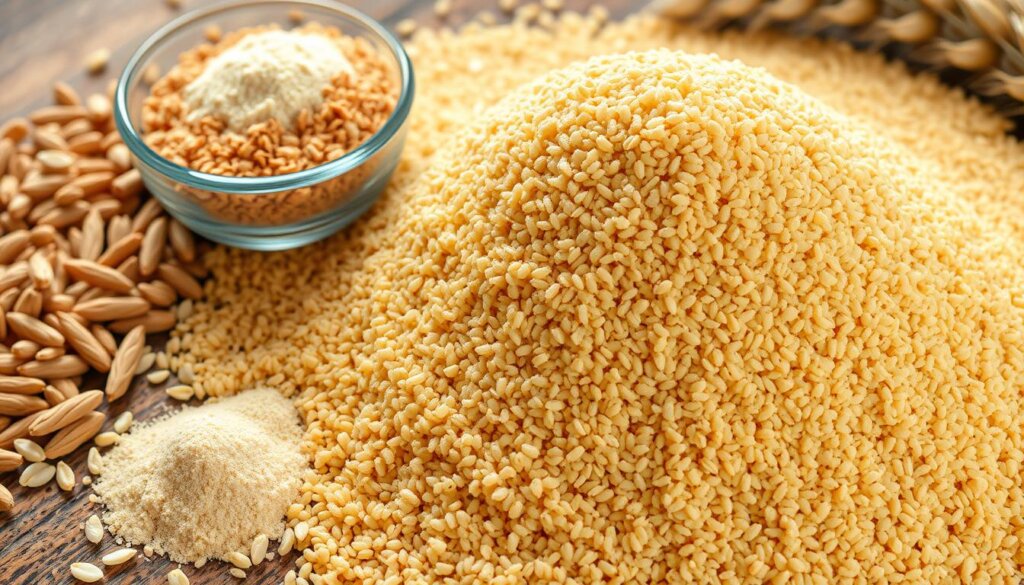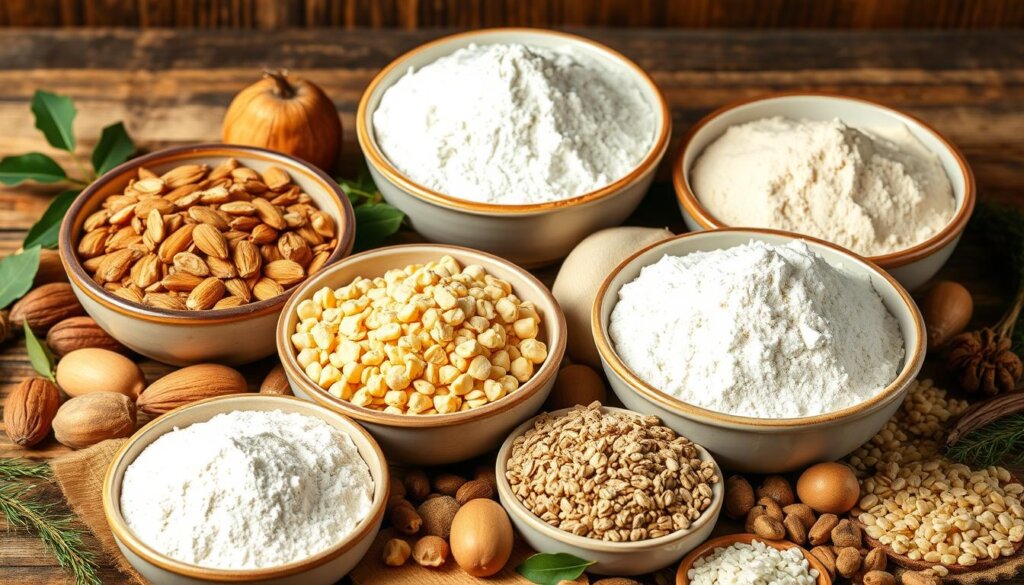Ever thought that your favorite pasta or pizza crust might be hiding gluten? Semolina, a key ingredient in many dishes, is the answer to this question.
Semolina comes from durum wheat, making it not gluten-free. It’s a big problem for people with celiac disease or wheat allergies. The high gluten content means it’s not safe for a strict gluten-free diet.
If you’re exploring gluten-free alternatives, check out our Easy Gluten-Free Grain-Free Wraps Recipe or learn how to make delicious Gluten-Free Lasagna. For a sweet twist, try our Gluten-Free Vanilla Cupcakes.
This article will dive into semolina’s composition, its nutritional value, and explore gluten-free substitutes to help you make better food choices and maintain a healthy diet.
Table of contents
Understanding Semolina and Its Origins
Semolina is a fascinating ingredient with deep roots in history. It comes from durum wheat and has been important in many cuisines for thousands of years. Its golden color and coarse texture make it great for many traditional dishes.
What is Semolina Made From
Semolina is made from durum wheat’s endosperm. This wheat is hard and has a lot of protein. It’s ground into a coarse flour with a bright yellow color.
This wheat is different from regular wheat in a few ways:
- It has more protein
- Its gluten is stronger
- It’s perfect for making pasta
Traditional Uses in Global Cuisines
Semolina is used in many dishes around the world. It’s in Italian pasta and Middle Eastern couscous. It’s a key ingredient in many food cultures:
| Region | Typical Semolina Dishes |
|---|---|
| Italy | Pasta, Gnocchi |
| Middle East | Couscous, Bulgur |
| India | Halwa, Upma |
| Nigeria | Semolina Porridge |
Nutritional Properties of Semolina
Semolina is very nutritious. A cup has about 21.2 grams of protein. It also has important minerals like iron and folate.
“Semolina transforms simple ingredients into extraordinary culinary experiences” – Culinary Expert
Its high protein content makes semolina a great choice for those looking for protein. It helps with energy and provides important nutrients for health.
Is Semolina Gluten Free

Wondering if semolina is gluten-free? The answer is no. Semolina comes from durum wheat and has a lot of wheat protein. This can cause problems for people with gluten sensitivity or celiac disease.
It’s important to know about semolina’s gluten content if you have dietary restrictions. About 80% of wheat protein is gluten. This makes semolina a big problem for those with wheat-related health issues.
“Semolina may look harmless, but its wheat origin means it’s packed with gluten that can cause significant health issues for sensitive individuals.”
- Semolina is made from durum wheat
- Contains high levels of wheat protein
- Unsuitable for people with celiac disease
- Triggers gluten sensitivity symptoms
Even though semolina looks like cornmeal, it’s actually a wheat product. It has a lot of gluten. People with gluten-related health issues should not eat semolina.
| Gluten Content Comparison | Percentage of Gluten |
|---|---|
| Semolina Flour | High (Around 80%) |
| All-Purpose Flour | Moderate (Around 70%) |
| Gluten-Free Alternatives | 0% |
If you’re looking for alternatives, there are many gluten-free flours. You can try rice flour, coconut flour, or almond flour. These options can help you enjoy a varied diet without the risks of gluten.
Nutritional Profile and Health Benefits of Semolina
Semolina is packed with nutrients, making it a great choice for those who care about their health. It’s made from wheat and is full of essential nutrients. These nutrients help support your overall well-being.
Protein and Nutrient Powerhouse
Semolina is a great source of protein. It has about 13 grams of protein per 100 grams. This is perfect for building muscles, which is great for athletes and fitness lovers.
- High protein content supports muscle growth
- Provides essential amino acids
- Helps in tissue repair and recovery
Iron and Essential Minerals
Semolina is also rich in minerals, like iron. It has important minerals that help meet your daily needs.
| Mineral | Amount per 100g | Percentage of RDA |
|---|---|---|
| Iron | 1.4 mg | 8% |
| Magnesium | 20 mg | 5% |
| Zinc | 0.4 mg | 3% |
Folate and Nutritional Considerations
Semolina is also a good source of folate. One serving has about 30 micrograms of folate. This supports cell growth and metabolism.
Glycemic Index Insights
For those watching their blood sugar, semolina’s glycemic index is worth noting. It has a glycemic index of 66. This means it releases energy slowly, making it a good carb source.
“Semolina provides sustained energy from complex carbohydrates, serving as a reliable fuel source for both body and brain.” – Nutritional Research
Even though semolina has many health benefits, those with gluten sensitivity should be careful. Always talk to a healthcare professional to see if semolina is right for you.
Common Foods Containing Semolina
Semolina is key in many global cuisines. It turns simple meals into amazing dishes. You’ll find it in many food types.

- Pasta: The heart of Italian cooking, semolina makes pasta with great texture
- Couscous: A must in North African dishes, it’s light and fluffy
- Bread: Adds flavor to artisan and traditional breads
- Desserts: Makes puddings, cakes, and sweets richer
Global cuisines use semolina in amazing ways. In the Mediterranean, it’s in both savory and sweet dishes. In the Middle East, it’s in detailed pastries and big meals.
| Cuisine Type | Semolina Dishes |
|---|---|
| Italian | Pasta, Pizza Crusts |
| North African | Couscous, Semolina Bread |
| Middle Eastern | Desserts, Savory Pastries |
| Indian | Upma, Sweet Halwa |
Chefs love semolina for its special qualities. It makes crispy textures in fried aubergine and adds a rich, nutty taste to many dishes.
“Semolina transforms ordinary ingredients into extraordinary culinary experiences” – Professional Chef
Medical Conditions Related to Gluten Sensitivity
Gluten sensitivity can lead to many complex health issues. These problems affect different parts of the body. Knowing about these conditions helps people spot health risks early and get the right medical help.
Celiac Disease: An Autoimmune Disorder
Celiac disease is a serious autoimmune condition found in about 1% of the world’s population. When people with this disease eat gluten, their immune system attacks the small intestine’s lining. This can cause serious nutritional problems and long-term health issues.
- Prevalence increases in white populations
- First-degree relatives have a 4-17% lifetime risk
- Symptoms include digestive issues, fatigue, and neurological problems
Wheat Allergies and Immune Responses
Wheat allergies are different from celiac disease. They involve specific reactions to wheat proteins. These reactions can cause a range of symptoms, from mild skin issues to severe breathing problems.
| Symptom Category | Potential Manifestations |
|---|---|
| Skin Reactions | Hives, itching, swelling |
| Respiratory | Nasal congestion, difficulty breathing |
| Digestive | Cramps, nausea, vomiting |
Other Gluten-Related Disorders
There are many gluten-related conditions beyond celiac disease and wheat allergies. These conditions can greatly affect a person’s health.
- Gluten Ataxia: A rare neurological disorder where gluten triggers immune system attacks on the nervous system, causing balance and coordination difficulties
- Dermatitis Herpetiformis: A chronic skin condition characterized by intensely itchy blistering rashes directly linked to gluten consumption
- Non-Celiac Gluten Sensitivity: A condition presenting similar symptoms to celiac disease without definitive serological markers
“Understanding your body’s unique response to gluten can be key to maintaining optimal health and preventing long-term complications.” – Nutritional Health Research Institute
Gluten-Free Alternatives to Semolina
Looking for semolina flour substitutes? There are many gluten-free options that taste great and work well in recipes. These alternatives add special qualities to your cooking and baking.

- Amaranth flour: It’s full of protein and has a nutty taste. Great for adding nutrition to your dishes.
- Buckwheat flour: It’s gluten-free and has a rich, earthy flavor. Perfect for many baked goods.
- Garbanzo flour: Made from chickpeas, it’s great for binding ingredients. Ideal for Indian and Mediterranean dishes.
- Rice flour: It’s light and versatile. Great for making smooth noodles and delicate baked goods.
- Potato starch: It’s neutral-tasting and perfect for thickening sauces. Also great for crispy textures.
Each flour has its own special qualities. Amaranth flour is high in protein, and buckwheat flour has a unique taste. Garbanzo flour is great for flatbreads and pancakes. Rice flour makes things light and fluffy, and potato starch helps with crispy coatings.
Pro tip: Try mixing these gluten-free flours to get the best texture and taste in your recipes.
Choosing a substitute depends on your cooking needs. Some flours are better for baking, while others are better for other dishes. Pick the one that fits your recipe and desired result.
Tips for Cooking with Semolina Substitutes
Gluten-free baking can be tricky, finding the right semolina flour substitute is key. Knowing how to adjust textures and recipes is vital for great results.
Baking Modifications
Choosing the right flour substitute for gluten-free baking is important. Each flour has its own texture and flavor that can change your dish.
- Rice flour is great for light, crispy textures
- Quinoa flour adds protein
- Amaranth flour has a nutty taste
- Almond flour makes baked goods rich and dense
Texture and Taste Considerations
Adjusting recipes is critical when using different flours. Each one can alter your dish’s texture and taste.
| Flour Type | Texture | Best Used For |
|---|---|---|
| Rice Flour | Light, crisp | Cookies, pastries |
| Quinoa Flour | Dense, hearty | Bread, muffins |
| Almond Flour | Moist, rich | Cakes, brownies |
Recipe Adaptations
Gluten-free baking needs trial and error. Blend different flours for the right texture. Start small and adjust liquids to match flour absorption.
Pro tip: Always test your recipe with a small portion first to understand how alternative flours behave.
Getting the hang of texture changes takes time. Be open to trying new things to make gluten-free recipes that are just as good as the originals.
Conclusion
Knowing about semolina’s gluten content is key for those on a gluten-free diet. Semolina comes from durum wheat and has a lot of gluten. This can cause big health problems for people with celiac disease or gluten sensitivity. It’s important to think about what you eat and find safe alternatives.
Looking for semolina substitutes, you’ll find many gluten-free choices. Rice flour is a great option for many dishes, matching semolina in texture and nutrition. Making smart food choices means knowing what’s in your food and picking things that fit your diet.
Living with gluten restrictions doesn’t mean you have to give up taste or fun. By knowing how gluten affects you and finding safe foods, you can make tasty, healthy meals. Every food you choose is important, and knowing about them helps you eat well.
Your health path is special, and choosing what you eat wisely is essential. Whether you have celiac disease, gluten sensitivity, or just want to eat better, being informed and active helps you make good food choices. This supports your health and well-being.
FAQ
Is semolina gluten-free?
No, semolina is not gluten-free. It comes from durum wheat, which has gluten. About 80% of wheat’s protein is gluten. So, semolina is not good for those with celiac disease, gluten sensitivity, or wheat allergies.
What is semolina typically used for?
Semolina is used in Italian, Indian, and Middle Eastern cooking. It’s for making pasta, couscous, breads, desserts, and thickening soups and stews. It’s also used to make dishes crispy.
What are the nutritional benefits of semolina?
One cup of semolina has 21.2 grams of protein, 7.28 milligrams of iron, and 306 micrograms of folate. It has low saturated fat and a lower glycemic index than regular wheat pasta. This makes it good for managing blood sugar.
What medical conditions are related to gluten sensitivity?
Gluten sensitivity is linked to celiac disease, wheat allergies, gluten ataxia, and dermatitis herpetiformis. These are all health issues.
What are some gluten-free alternatives to semolina?
You can use amaranth flour, buckwheat flour, garbanzo flour, rice flour, potato starch, arrowroot, millet flour, oat flour, and tapioca starch. Each has its own uses in cooking.
How can I substitute semolina in recipes?
Choose a substitute based on the recipe’s needs. Amaranth flour thickens, buckwheat flour mixes with other flours, and rice flour is good for noodles and baked goods. Try different mixes to get the right texture and taste.
What symptoms are associated with gluten sensitivity?
Symptoms include digestive problems, fatigue, neurological issues, hives, and breathing trouble. Celiac disease can cause more serious reactions to gluten.
Can people with celiac disease eat semolina?
No, people with celiac disease can’t eat semolina. It has gluten, which can harm their digestive system and trigger immune reactions.
Is semolina healthier than flour?
Semolina is more nutrient-dense than regular flour, containing higher protein, fiber, and essential minerals, but it’s not suitable for gluten-free diets.
Is semolina flour inflammatory?
Yes, semolina flour can be inflammatory for those sensitive to gluten or with celiac disease, as it is made from wheat.





